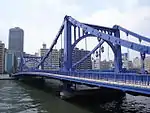List of Cultural Properties of Japan - structures (Saga)
This list is of the Cultural Properties of Japan designated in the category of structures (建造物, kenzōbutsu) for the Prefecture of Saga.[1]
National Cultural Properties
As of 1 March 2015, thirteen Important Cultural Properties with sixteen component structures have been designated, being of national significance.[2][3][4]
| Property | Date | Municipality | Comments | Image | Coordinates | Ref. |
|---|---|---|---|---|---|---|
| Yoshimura Family Residence 吉村家住宅 Yoshimura-ke jūtaku | 1789 | Saga |  | 33°27′28″N 130°11′49″E | ||
| Former Takatori Family Residence 旧高取家住宅 kyū-Takatori-ke jūtaku | 1904 | Karatsu | designation comprises two components: the buildings for the large central room (hiroma) and living room (kyoshitsu) | 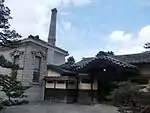 | 33°27′16″N 129°58′19″E | |
| Saga Castle Shachinomon and Tsuzuki Yagura 佐賀城鯱の門及び続櫓 Saga-jō shachi-no-mon oyobi tsuzuki-yagura | 1836 | Saga |  | 33°14′45″N 130°18′10″E | ||
| Yamaguchi Family Residence 山口家住宅 Yamaguchi-ke jūtaku | Meiji period | Saga |  | 33°10′32″N 130°20′27″E | ||
| Nishioka Family Residence 西岡家住宅 Nishioka-ke jūtaku | end of Edo period | Ureshino |  | 33°07′48″N 130°03′36″E | ||
| Kawauchi Family Residence 川打家住宅 Kawauchi-ke jūtaku | Edo period | Taku | 33°15′49″N 130°03′10″E | |||
| Taku Seibyō 多久聖廟 Taku Seibyō | 1708 | Taku |  | 33°15′36″N 130°05′52″E | ||
| Tashima Jinja Honden 田嶋神社本殿 Tashima Jinja honden | early Muromachi period | Imari | 33°21′54″N 129°52′30″E | |||
| Doi Family Residence 土井家住宅 Doi-ke jūtaku | end of Edo period | Ōmachi |  | 33°12′50″N 130°07′22″E | ||
| Takeo Onsen Shinkan and Rōmon 武雄温泉新館及び楼門 Takeo onsen shinkan oyobi rōmon | 1914 | Takeo | designation comprises two components: shinkan and rōmon | 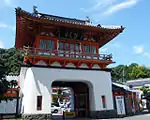 | 33°11′48″N 130°00′52″E | |
| Yoga Jinja Third Torii and Stone Bridge 与賀神社三の鳥居及び石橋 Yoga Jinja san-no-torii oyobi ishi-bashi | 1603 | Saga | designation comprises two components: third torii and stone bridge | 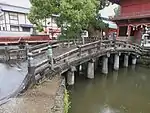 | 33°14′56″N 130°17′40″E | |
| Yoga Jinja Rōmon 与賀神社楼門 Yoga Jinja rōmon | Momoyama period | Saga |  | 33°14′56″N 130°17′40″E | ||
| Chikugo River Lift Bridge 旧筑後川橋梁(筑後川昇開橋) kyū-Chikugo-gawa kyōryō (Chikugo-gawa shōkaikyō) | 1935 | Saga | designation spans the borders with Ōkawa, Fukuoka |  | 33°12′54″N 130°21′42″E | |
Prefectural Cultural Properties
As of 1 October 2014, nineteen properties with twenty-one component structures have been designated at a prefectural level.[4][5]
| Property | Date | Municipality | Comments | Image | Coordinates | Ref. |
|---|---|---|---|---|---|---|
| Kashii Jinja Shikyakumon 香椎神社四脚門 Kashii Jinja Shikyakumon | early Edo period | Saga | 33°14′58″N 130°14′10″E | |||
| Kashima Castle Akamon and Ōtemon 鹿島城赤門及び大手門 Kashima Jinja Akamon oyobi Ōtemon | early C19 | Kashima |  | 33°06′10″N 130°05′36″E | ||
| Wakamiya Hachimangū Shinden 若宮八幡宮神殿 Wakamiya Hachimangū shinden | early Edo period | Taku | 33°15′29″N 130°05′27″E | |||
| Takezaki Kannon Stone Three-Storey Pagodas 竹崎観音石造三重塔 Takezaki Kannon seki-zō sanjūtō | end of Kamakura period | Tara | two tō | 32°57′26″N 130°13′11″E | ||
| Murozono Jinja Stone Hizen Torii 石造肥前鳥居 seki-zō Hizen torii | 1590 | Karatsu | 33°19′17″N 130°03′47″E | |||
| Ushio Jinja Stone Hizen Torii 石造肥前鳥居 seki-zō Hizen torii | 1597 | Ogi | 33°15′32″N 130°10′59″E | |||
| Kushida-gū Stone Hizen Torii 石造肥前鳥居 seki-zō Hizen torii | 1602 | Kanzaki | 33°18′36″N 130°22′21″E | |||
| Honjō Jinja Stone Hizen Torii 石造肥前鳥居 seki-zō Hizen torii | 1603 | Saga | 33°14′38″N 130°16′56″E | |||
| Hatten Jinja Stone Bridge 石造眼鏡橋 seki-zō megane-bashi | 1852 | Ureshino | 33°06′03″N 130°03′24″E | |||
| Seigan-ji Rōmon 星巌寺楼門 Seiganji rōmon | 1852 | Ogi | 33°17′57″N 130°11′11″E | |||
| Ōdō Jinja Stone Myōjin Torii 銅造明神鳥居 dō-zō Myōjin torii | 1640 | Saga | 33°14′12″N 130°21′57″E | |||
| Yūtoku Inari Jinja Precinct Myōbusha 祐徳稲荷神社境内社命婦社 Yūtoku Inari Jinja keidai sha myōbusha | 1804 | Kashima |  | 33°04′24″N 130°06′29″E | ||
| Arita Ijinkan 有田異人館 Arita Ijinkan | 1876 | Arita | 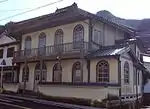 | 33°11′24″N 129°53′52″E | ||
| Former Mitsubishi Gōshi Kaisha Karatsu Branch Honkan 旧三菱合資会社唐津支店本館 kyū-Mitsubishi gōshi kaisha Karatsu shiten honkan | 1908 | Karatsu | preserved as the Karatsu City Museum of History and Folklore (唐津市歴史民族資料館) |  | 33°28′15″N 129°57′14″E | |
| Jissō-in Niōmon 実相院仁王門 Jissō-in Niōmon | early Edo period | Saga | 33°19′39″N 130°16′02″E | |||
| Yodohime Jinja West Gate 与止日女神社西門 &odohime Jinja nishi mon | 1573 | Saga |  | 33°19′35″N 130°16′06″E | ||
| Kōden-ji Shakadō 高伝寺釈迦堂 Kōdenji Shakadō | 1655 | Saga | 33°14′16″N 130°16′59″E | |||
| Seigan-ji Otamaya 星巌寺御霊屋 Seiganji otamaya | mid-C18 | Ogi | 33°17′57″N 130°11′11″E | |||
| Former Nakao Family Residence - Main Building 旧中尾家住宅主屋 kyū-Nakao-ke jūtaku shuoku | C18 | Karatsu | 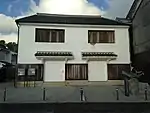 | 33°32′23″N 129°53′41″E | ||
Municipal Cultural Properties
As of 1 May 2014, one hundred and two properties have been designated at a municipal level.[6]
Registered Cultural Properties
As of 1 March 2015, ninety-four properties at thirty-five sites have been registered (as opposed to designated) at a national level.[4][7]
| Property | Date | Municipality | Comments | Image | Coordinates | Ref. |
|---|---|---|---|---|---|---|
| Muraoka Sōhonpo Yōkan Museum 村岡総本舗羊羹資料館 Muraoka Sōhonpo yōkan shiryōkan | 1941 | Ogi |  | 33°18′05″N 130°12′15″E | ||
| Chōkokan 徴古館 Chōkokan | 1927 | Saga |  | 33°15′06″N 130°18′05″E | ||
| Takeya 竹屋 Takeya | 1923 | Karatsu | 33°26′55″N 129°58′13″E | |||
| Sueyama Jinja Torii 陶山神社鳥居 Sueyama Jinja torii | 1888 | Arita | ceramic torii |  | 33°11′20″N 129°53′57″E | |
| Yoga Jinja Honden - Heiden - Haiden 与賀神社本殿・幣殿・拝殿 Yoga Jinja honden-heiden-haiden | 1758-59 | Saga | the heiden-haiden were repaired in 1913 | 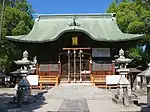 | 33°14′59″N 130°17′46″E | |
See also
References
- "Pamphlet on Cultural Properties". Agency for Cultural Affairs. Archived from the original on 26 October 2014. Retrieved 28 March 2015.
- 国宝・重要文化財 [Number of National Treasures and Important Cultural Properties by Prefecture] (in Japanese). Agency for Cultural Affairs. 1 March 2015. Archived from the original on 30 June 2011. Retrieved 28 March 2015.
- "Database of National Cultural Properties: 国宝・重要文化財(建造物) (佐賀県)" (in Japanese). Agency for Cultural Affairs. Archived from the original on 4 December 2015. Retrieved 28 March 2015.
- 佐賀県内所在指定文化財等件数一覧 [Number of Cultural Properties in Saga Prefecture] (in Japanese). Saga Prefecture. 27 October 2014. Retrieved 28 March 2015.
- 都道府県別指定等文化財件数(都道府県分) [Number of Prefectural Cultural Properties by Prefecture] (in Japanese). Agency for Cultural Affairs. 1 May 2014. Archived from the original on 21 September 2013. Retrieved 28 March 2015.
- 都道府県別指定等文化財件数(市町村分) [Number of Municipal Cultural Properties by Prefecture] (in Japanese). Agency for Cultural Affairs. 1 May 2014. Archived from the original on 14 May 2015. Retrieved 28 March 2015.
- 登録文化財 [Number of Registered Cultural Properties by Prefecture] (in Japanese). Agency for Cultural Affairs. 1 May 2014. Archived from the original on 30 June 2011. Retrieved 28 March 2015.
External links
- (in Japanese) Cultural Properties in Saga Prefecture
This article is issued from Wikipedia. The text is licensed under Creative Commons - Attribution - Sharealike. Additional terms may apply for the media files.


